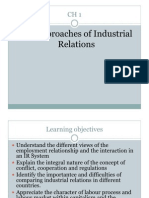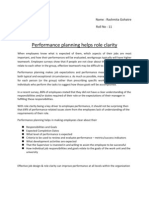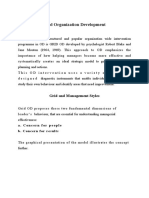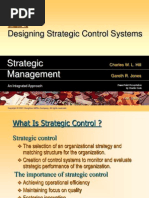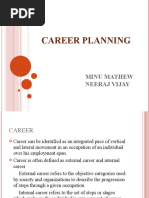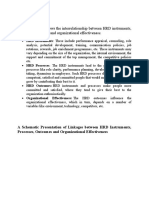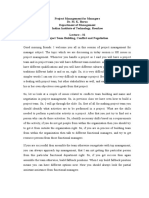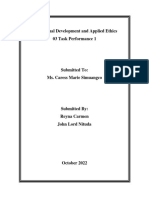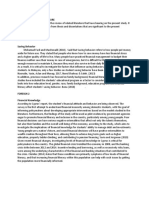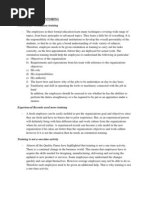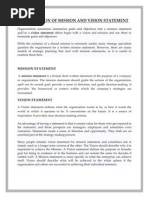Career Planning Intervention
Career Planning Intervention
Uploaded by
sid_narayanan4971Copyright:
Available Formats
Career Planning Intervention
Career Planning Intervention
Uploaded by
sid_narayanan4971Copyright
Available Formats
Share this document
Did you find this document useful?
Is this content inappropriate?
Copyright:
Available Formats
Career Planning Intervention
Career Planning Intervention
Uploaded by
sid_narayanan4971Copyright:
Available Formats
Career Planning Intervention
Career planning is the process of defining individual career objectives. Though an individual uses this process to plan through various stages of his/her life, this process becomes extremely pertinent from the perspective of the organization. One of the most important drivers of employee performance is the line-of-sight that the individual has from the perspective of his/her career in the organization. Personalized career planning can enable the organization understand the ambitions/inclinations of the employee and help him/her chart a plan to pursue it. This generally involves assessment of the employees interests, capabilities and goals and planning to pursue them. It also involves decisions that affect the current job, the acceptance of promotions, transfers among other things. To address the career planning issues at KEC Internationals Design and Distribution SBU, we propose interventions at the stages of an employees career mentioned below. This model could be adopted across SBUs at KEC International as they are all lacking in career planning processes. Establishment stage At this stage, the employee is new to the organization, probably fresh out of college and has just stepped in to the responsibilities of adulthood. He/she is starting a professional career and is stressed by the task of identifying the correct path and performing effectively. On the personal front, the employee may be considering major decisions like starting a family, having children etc. The organizations role at this stage begins at the time of the selection of the employee wherein it discusses with the employee about his/her ambitions/expectations and provides realistic feedback about the possible career path in the organization. The organization then assigns the employee 4 guides with different roles who could change as required. They are: Tutor y Responsible for training the employee at a particular stint y Helps the employee plan for the stint y Evaluates the performance of the employee during the stint Mentor y A senior manager from the SBU to which the employee belongs y Assists in overall career planning and development Buddy y A senior (1-3 years) from the same institute of the employee y Helps ease the employee into the organizations environment y Non evaluative responsibilities
Coach y A role model for the employee y Periodically reviews the employees progress in each stint and advices for improvement The presence of the four guides will provide the employee with a sense of security and the right means to seek assistance for different areas of career planning. How to go about it? Communication KEC must constantly communicate to the employee through various channels written as well as oral providing information about opportunities within KEC as well as feedback about the employees performance. What combination of skills and experience required to progress to the next level should be clear. The variable component of the same (economic scenario, performance of business unit, extraordinary feedback etc) should also be conveyed to the employees. Usage of GE Mckinseys Matrix Use GE McKinseys Matrix (Performance vs Potential) to plot the employees. Then the employees falling in high performance & high potential grid (Inverted L in green in the diagram) are considered for Career Management.
Figure 1. GE McKinsey s Matrix
Internal Job Postings Promote a culture of internal job postings by ensuring that the system has flexibility enough so that the employees can shift to a vertical or position depending upon their competency. This will in turn provide the career planning and management of the employees a wider scope and also result in higher satisfaction level amongst the employees. Goal setting in the Performance Appraisal Process The KRA and goal setting to be done by superior and HR manager together in the presence of Mentor and coach. This will bring a complete organization picture as HR manager will know what are the average goals set up by all the superiors and will remove the factor of strategic orientation of the superior. This will allow the time for cross verification of the KRAs. This change will thus improve the discussion while goal setting and hence reduce the dissatisfaction of the employees by reducing the superior bias.
You might also like
- HoopNotes - 14 May 2014 - Book Review, Win Forever by Pete CarrollDocument11 pagesHoopNotes - 14 May 2014 - Book Review, Win Forever by Pete CarrollJulianFields100% (1)
- Classroom and Group Action PlanDocument3 pagesClassroom and Group Action Plannv100% (2)
- Organisational Development and Change Assignment: School of Management Studies Punjabi University, PatialaDocument7 pagesOrganisational Development and Change Assignment: School of Management Studies Punjabi University, PatialaIshan GoyalNo ratings yet
- Organizational Mirroring InterventionDocument4 pagesOrganizational Mirroring InterventionSimran67% (3)
- Dunlop ModelDocument38 pagesDunlop Modelakruti_sharma100% (2)
- Assignment 1 - Talent Management (19BBA10015)Document4 pagesAssignment 1 - Talent Management (19BBA10015)Kartik0% (1)
- Human and Cultural Variables in Global OrganizationDocument3 pagesHuman and Cultural Variables in Global OrganizationVijender Singh33% (3)
- Sales Control & Cost AnalysisDocument17 pagesSales Control & Cost Analysisbhavesh patel33% (3)
- Macro and Micro Level HRPDocument17 pagesMacro and Micro Level HRPsahilNo ratings yet
- Performance Planning Helps Role ClarityDocument2 pagesPerformance Planning Helps Role ClarityRashmita Az100% (1)
- Parallel Learning StructuresDocument10 pagesParallel Learning StructuresTunisha Jethwani100% (1)
- Strategic Human Resources Development Facilitators: DR A Jagan Mohan Reddy SIBM, SIU, HyderabadDocument19 pagesStrategic Human Resources Development Facilitators: DR A Jagan Mohan Reddy SIBM, SIU, Hyderabadsrishti bhatejaNo ratings yet
- CH 5 - Role Focused OD InterventionsDocument30 pagesCH 5 - Role Focused OD InterventionsRiddhi Bhatia100% (2)
- HRD Matrix: Submitted byDocument21 pagesHRD Matrix: Submitted bykusumNo ratings yet
- Compensation Management & Job EvaluationDocument20 pagesCompensation Management & Job EvaluationSunil Patnaik100% (1)
- Emergence of OD As An Applied Behavioral ScienceDocument10 pagesEmergence of OD As An Applied Behavioral ScienceNive Anbu0% (1)
- Training Climate and PedagogyDocument8 pagesTraining Climate and Pedagogyyuda rahadian100% (1)
- Compensation As A Motivational Tool1Document11 pagesCompensation As A Motivational Tool1Manya Kapoor100% (4)
- Facilities Planning & Training AidsDocument9 pagesFacilities Planning & Training AidsFibin Haneefa100% (1)
- Grid Organization DevelopmentDocument4 pagesGrid Organization DevelopmentSimranNo ratings yet
- Confrontation Meeting DetailsDocument2 pagesConfrontation Meeting Detailsnahu100% (1)
- Enumerating The AssetsDocument11 pagesEnumerating The AssetsShikha Dubey0% (1)
- Changing Role of HRDDocument10 pagesChanging Role of HRDRenjul Paravur100% (1)
- Performance ApprisalDocument101 pagesPerformance Apprisalchiragjoshi100% (3)
- HRD MatrixDocument1 pageHRD MatrixMann Jett PradhanNo ratings yet
- Role Focused OD InterventionsDocument12 pagesRole Focused OD InterventionsJyoti Dave100% (1)
- ConclusionDocument3 pagesConclusionAnimesh TiwariNo ratings yet
- Lecture 2 (Objectives & Role of TM) - Notes Meaning & ObjectivesDocument5 pagesLecture 2 (Objectives & Role of TM) - Notes Meaning & ObjectivesDr. Gagandeep KaurNo ratings yet
- Labour Markets and Stock Taking... Shahid ElimsDocument19 pagesLabour Markets and Stock Taking... Shahid Elimsshahid veettilNo ratings yet
- Potential AppraisalDocument6 pagesPotential AppraisalResham Daswal50% (2)
- Laboratory TrainingDocument29 pagesLaboratory TrainingNkvNo ratings yet
- Potential Appraisal BBADocument25 pagesPotential Appraisal BBAAzra IshratNo ratings yet
- IHRMDocument7 pagesIHRMRAJDIP MAZUMDERNo ratings yet
- Coaching & Performance ManagementDocument38 pagesCoaching & Performance ManagementTracy AdraNo ratings yet
- HRM in Knowledge EconomyDocument13 pagesHRM in Knowledge EconomyTayyab Ahmed Chughtai100% (1)
- Performance Management System in BanksDocument22 pagesPerformance Management System in BanksAmey N Kantak50% (2)
- Intergroup and Third Party Peacemaking InterventionsDocument23 pagesIntergroup and Third Party Peacemaking InterventionsRohit Kumar Singh81% (16)
- Approaches To HRPDocument16 pagesApproaches To HRPAltaf Kondakamarala100% (2)
- Designing Strategic Control SystemDocument15 pagesDesigning Strategic Control Systemin_visible50% (2)
- Problems With Job AnalysisDocument9 pagesProblems With Job AnalysisMlenins Vja67% (3)
- Person Focused Od InterventionsDocument16 pagesPerson Focused Od InterventionsSneha ShankarNo ratings yet
- Using Talent Management To Drive A Culture of ExcellenceDocument2 pagesUsing Talent Management To Drive A Culture of ExcellenceHARSHIT KUMARNo ratings yet
- Changing Profiles of Major Stakeholders of Industrial Relations in IndiaDocument13 pagesChanging Profiles of Major Stakeholders of Industrial Relations in IndiaRichard Martinez100% (1)
- Chapt-8 Re-Entry & Career IssuesDocument21 pagesChapt-8 Re-Entry & Career IssuesHabibAfzalNo ratings yet
- Performance Management SystemDocument25 pagesPerformance Management SystemSovan NandyNo ratings yet
- Components of OdDocument54 pagesComponents of OdSurbhi Sofat100% (2)
- Activity Areas of HRDDocument16 pagesActivity Areas of HRDDrPurnima SharmaNo ratings yet
- Employee RemunerationDocument22 pagesEmployee RemunerationJagruti Bhansali100% (3)
- Global HRMDocument23 pagesGlobal HRMPreeti Bhaskar100% (2)
- Managerial Jobs Models and MethodsDocument10 pagesManagerial Jobs Models and Methodsrakum81No ratings yet
- Indian HRD Climate and PracticesDocument4 pagesIndian HRD Climate and PracticesRohit KumarNo ratings yet
- Competency Mapping: Class - Bba 6 Semester Subject - Talent and Knowledge Management Unit - 2Document13 pagesCompetency Mapping: Class - Bba 6 Semester Subject - Talent and Knowledge Management Unit - 2komal nagarNo ratings yet
- Principles in Designing HRD SystemDocument4 pagesPrinciples in Designing HRD SystemMani KandanNo ratings yet
- Job Satisfaction A Complete Guide - 2020 EditionFrom EverandJob Satisfaction A Complete Guide - 2020 EditionRating: 5 out of 5 stars5/5 (1)
- 3.1 Evaluate Business Performance and The Role of HR in Business Planning and The Change Management AgendaDocument2 pages3.1 Evaluate Business Performance and The Role of HR in Business Planning and The Change Management AgendaKam RaiNo ratings yet
- HRD MatrixDocument7 pagesHRD MatrixChhavi GargNo ratings yet
- Career Planning: Minu Mathew Neeraj VijayDocument14 pagesCareer Planning: Minu Mathew Neeraj Vijayminuannapoovelil7642No ratings yet
- The HRD Matrix Shows The Interrelationship Between HRD Instruments, Processes, Outcomes and Organizational EffectivenessDocument11 pagesThe HRD Matrix Shows The Interrelationship Between HRD Instruments, Processes, Outcomes and Organizational Effectivenessprayas786No ratings yet
- Unit 8 Career PlanningDocument7 pagesUnit 8 Career PlanningVishnu LataNo ratings yet
- AssignmentDocument19 pagesAssignmentshohelrn29No ratings yet
- Benefits of A Performance Management SystemDocument13 pagesBenefits of A Performance Management SystemGopalakrishnan KuppuswamyNo ratings yet
- Logframe Templates and GuidanceDocument7 pagesLogframe Templates and GuidanceNorvan Aji SatrioNo ratings yet
- PART IV Developmental PlanDocument1 pagePART IV Developmental PlanJoje Sadili CostañosNo ratings yet
- Unit 2 Understanding Firm Specific EnvtDocument33 pagesUnit 2 Understanding Firm Specific Envtgiya.kushathaNo ratings yet
- Financial LiteracyDocument22 pagesFinancial LiteracyRio Albarico100% (1)
- Time ManagementDocument45 pagesTime Managementaarti.takawaneNo ratings yet
- CBMEDocument7 pagesCBMEJerico EnamnoNo ratings yet
- Internship Report: Learning and Development Division of BRAC Bank Limited: "Training Needs Assessment"Document64 pagesInternship Report: Learning and Development Division of BRAC Bank Limited: "Training Needs Assessment"Anisur RahmanNo ratings yet
- MG309 NDocument15 pagesMG309 Nkishan100% (1)
- Grade 8 Sample Lesson Plan: Unit 5 - SMART Goal-Setting To Stay FitDocument4 pagesGrade 8 Sample Lesson Plan: Unit 5 - SMART Goal-Setting To Stay FitNicolee Leah IINo ratings yet
- 644375458f16960018424d0a ## Nature and Significance of ManagementDocument5 pages644375458f16960018424d0a ## Nature and Significance of ManagementKashvi SharmaNo ratings yet
- Building A Successful Consulting PracticeDocument22 pagesBuilding A Successful Consulting PracticeParag PenkerNo ratings yet
- How To Plan Your Day and Stick To ItDocument8 pagesHow To Plan Your Day and Stick To Itbal_thakreNo ratings yet
- Lec 31Document14 pagesLec 31venkatachalapathy.thNo ratings yet
- It Strategic Framework Presentation Ppt4160Document24 pagesIt Strategic Framework Presentation Ppt4160Devesh VermaNo ratings yet
- Adiba TabassumDocument100 pagesAdiba TabassumANKIT SINGHNo ratings yet
- HRM (Employee Motivation Through Quality Leadership)Document10 pagesHRM (Employee Motivation Through Quality Leadership)noreen rafiqNo ratings yet
- Carmen Nituda Task Performance Professional Development and Applied EthicsDocument4 pagesCarmen Nituda Task Performance Professional Development and Applied EthicsreighnaNo ratings yet
- Organization TheoryDocument11 pagesOrganization TheoryAnas TariqNo ratings yet
- Unit 05 Event EvaluationDocument25 pagesUnit 05 Event Evaluationchirag raoNo ratings yet
- H.mohamed Ibrahim Hussain A Study On Technology Updatiing and Its Impact Towards Employee Performance in Orcade Health Care PVT LTD ErodeDocument108 pagesH.mohamed Ibrahim Hussain A Study On Technology Updatiing and Its Impact Towards Employee Performance in Orcade Health Care PVT LTD ErodeeswariNo ratings yet
- Cess RRLDocument2 pagesCess RRLPrincess Regidor100% (1)
- Dba 403-1 EnterpreneurshipDocument97 pagesDba 403-1 EnterpreneurshipsharonNo ratings yet
- TQMDocument6 pagesTQMAllan MoralesNo ratings yet
- Sample Development Plan TemplateDocument5 pagesSample Development Plan TemplateAnayaNo ratings yet
- Worksheets and Handouts CravingsAddictionsDocument16 pagesWorksheets and Handouts CravingsAddictionsMaicon ThiagoNo ratings yet
- Test 2BDocument13 pagesTest 2BJoesmithNo ratings yet
- Mission and Vision StatementsDocument5 pagesMission and Vision Statementsumarmalik38100% (1)
- Not at All (Hindi Kailanman) Rarely (Bihira) Sometimes (Minsan) Often (Paminsan-Minsan) Very Often (Madalas)Document4 pagesNot at All (Hindi Kailanman) Rarely (Bihira) Sometimes (Minsan) Often (Paminsan-Minsan) Very Often (Madalas)Paul XavierNo ratings yet




